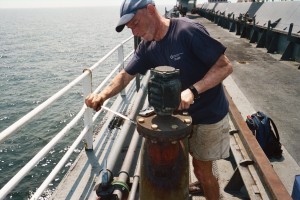
SERC researcher George Smith opens an air vent on the ship Patcantrell for a ballast water experiment. (Credit: Timothy Mullady/SERC)
The global economy depends on marine transportation. But in addition to cargo, the world’s 50,000-plus commercial ships carry tiny stowaways that can cause huge problems for the environment and economy. A new model, published Thursday in the journal Environmental Science & Technology, will help ships screen more accurately for dangerous species before they unload.
Ballast water taken up by ships in ports and coastal waters is teeming with plankton and microbes. When discharged at the next port of call, these hitchhikers can wreak havoc on receiving ecosystems. Under current federal regulations, ships exchange their ballast water in the open ocean to flush out unwanted species. However, some survive the process, and not all ships travel across oceans. Environmental regulators have known about this problem for decades. But while regulators check ship records and can sometimes test salinity to verify compliance, unlike many pollutants, there are no federal requirements limiting the number of viable, potentially dangerous organisms.
That is about to change. The U.S. Coast Guard has proposed a new set of rules limiting the number of organisms allowed, in line with current International Maritime Organization standards. For larger zooplankton (length, width or height at least 50 microns, or one-half the thickness of a piece of paper), the number must be fewer than 10 viable organisms per cubic meter (264 gallons). On-board ballast water treatment technologies offer a promising solution, enabling ships to substantially cut the risk of delivering dangerous species. But while a few systems have entered the market, the challenge of testing the ballast water – and the technology – remains. A major stumbling block is simply understanding how much ballast water must be tested in order to count very sparse numbers of organisms.
To help regulators and engineers develop and test such treatment systems, and ultimately enforce these standards, a team of researchers developed a statistical model to see how to count small, scarce organisms in large volumes of water accurately. Led by Whitman Miller of the Smithsonian Environmental Research Center, the scientists took samples that exceeded the limit and ran them through various tests to see which violations would be spotted. Larger samples gave the best results: Sampling only 0.1 cubic meter of water (26.4 gal) made it difficult to detect concentrations even twice as high as the standard (20 zooplankton per cubic meter). By contrast, when they raised the volume to 7 cubic meters (1848 gal), the test regularly picked up violations as low as 13 zooplankton per cubic meter.
Another innovation of the model is that it recognizes sample results can be pooled over time and possibly across ships, making it easier to determine if treatment systems function as advertised and thus whether ships are actually compliant or not. Since analyzing samples larger than 7 cubic meters is difficult for most cargo ships, by taking multiple 7 cubic-meter samples, regulators can effectively raise the volume without overburdening the ships.
“When trying to decide how to evaluate a treatment system, we need to balance scientific rigor with what is logistically feasible,” Miller says.
“The findings of this study will greatly assist the Coast Guard,” says USCG scientist Richard Everett, not only for testing treatment systems and ships, but for the larger goal of protecting coastal ecosystems from harmful organisms.
The Coast Guard proposal would require most ships arriving in U.S. waters to have on-board ballast water treatment systems that dramatically reduce the number of living organisms in their discharge. Under the proposed regulation, most existing ships would have until 2014 or 2016 to comply, but any ships built after January 1, 2012, would need to comply immediately. The agency estimated in 2009 that the new regulation could cost as much as $168 million a year, largely for ships to install the new technologies necessary to comply. However, in terms of economic and environmental damage avoided, it could save anywhere from $165 to $585 million a year.
The Coast Guard is also considering implementing a second phase of regulations, which would be up to 1,000 times more stringent than the International Maritime Organization standards. This could begin as early as 2016, but it is subject to an assessment of practicability.
With the rules changing so rapidly, the pressure for technology to keep pace is rising. “We think that science can help inform regulatory efforts,” Miller says. “However, in the end, it is necessary for regulators to determine the level of environmental protection that is acceptable in accordance with both scientific evidence and the needs and desires of society.”
-by Kristen Minogue

